 Image search results - "woman" Image search results - "woman" |

The biggest taiko drum festival in the Kanto region is held annually in April. Various taiko drum troupes perform for two full days on various outdoor stages in Narita, including the main stage in front of the Narita-san temple.
|
|
|
|

Plum Blossom Queen at Kairakuen StationShe was passing out maps of the garden. It was a nice touch to see two of these kimono beauties greeting us.
|
|
|
|

Plum Blossom Queen
|
|
|
|
|
|
|
|
|
|
|
|
|
|
|
|
|
|
|
|
|
|
|
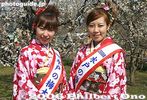
Plum Blossom Queens in Kairakuen, Mito
|
|

Plum Blossom Queens in Kairakuen, Mito
|
|

Here's one reason for the crowd...
|
|
|

And another one. Young pretty/cute girls in costume pass out flyers, but end up being street models for amateur photographers who have no girlfriends to shoot.
|
|

They are happy to pose...
|
|

The maid costume is all the rage in Japan, for several years now.
|
|

Santa suit appears in Dec.
|
|

Pagoda and maiko
|
|
|
|

Standard uniform of portable shrine bearers (for both men and women).The headband may be tied at the front or back of the head. It may also be tied on the head like a bonnet. There is a variety of ways of tying the headband.
The happi coat bears the name of the parish or district the person belongs to. The same name is displayed on the respective portable shrine. The shorts are white and skintight. Worn by both men and women. Also called Han-momo or Han-momohiki. The white tabi (sock-like shoe) has a rubber sole.
|
|
|
|

Maids to greet you
|
|

Maids, the costume rage in Japan for several years already.
|
|

Welcome!
|
|
|

Tokyo Anime Center
|
|

Many life-size costumed characters on display.
|
|
|

Tokyo Anime Center, Akihabara
|
|

Big expressive eyes.
|
|

Straight black hair is pretty too.
|
|

Blue ponytails
|
|

Goldilocks?
|
|

Space teen?
|
|
|

School uniform
|
|
|

Redhead in school uniform
|
|
|
|

Anybody who knows the names of these characters are welcome to enlighten me...
|
|

Sakura
|
|

Merry Christmas
|
|
|
|
|
|
|

Pikachu, Astro Boy, Doraemon
|
|

They sing on the street to advertise something, usually a night club where they appear.
|
|

The ever-popular maid outfit.
|
|
|

Maids attract much attention so they are used as living billboards for stores and whatever needs to be advertised in Akihabara.
|
|

Miss Ebisu-bashi Runner-up
|
|

Cosplayer teenager posing on the road.
|
|

Miss Ebisu-bashi Runner-up
|
|

The problem is that the police patrol the main drag to expel these street performers. It is not allowed. It would be the Japanese police to try and kill Japan's street culture.
|
|

Shinsaibashi Top Lady
|
|

Street singer in front of JR Akihabara Station's new Central entrance
|
|

Street singer in front of JR Akihabara Station's new Central entrance. A cute face and miniskirt really help to gather a crowd.
|
|

Her setup is simple. A portable and battery-powered amplifier connected to a microphone. The amp is on a luggage cart. When the police comes, she can pack up and leave within 5 sec.
|
|

These girls usually have a lookout man who watches out for the cops. As soon as he sees one coming, he runs up to her and gives the "Outta here" signal. They're gone before the police can even see them. It's a constant cat and mouse game
|
|

She says that it was her first "Street live performance" (rojo raibu).
|
|
|

Street performer
|
|

Street performer near Yodobashi-Akiba, the largest store in Akihabara.
|
|

A miniskirted pair
|
|

Another Shinsaibashi Top Lady
|
|
|
|
|
|
|
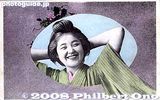
Out of all the geisha that have appeared on postcards, this ever-smiling geisha was unsurpassed in popularity. Her smiling visage appeared in 40 to 50 different poses in photographs and postcards made in Yokohama from the 1890s.
|
|

Her affable and infectious smile made her stand out during a time when most people posing for a photograph did not smile.
|
|
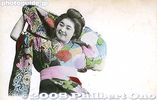
Her name has been a mystery, but I have come across hard evidence that she was a geisha named "Tokimatsu." But I will forever call her the "Laughing Geisha."
|
|
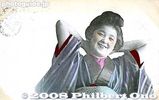
A saucy little Geisha. The pose is good.
|
|

Laughing Geisha with low neck. She's almost semi-nude. It is probably her sexiest pose of all. A great summertime card and one of my favorites. Hand-colored and postmarked Feb. 25, 1908 in Yokohama. The actual card is more yellowed.
|
|

Laughing Geisha with cowboy hat & cigar. This must be the most humorous pose she created. Those tourists must've gotten a big kick when they saw this card. A geisha from the wild, wild West. Even today, it elicits an affectionate laugh. One of my
|
|
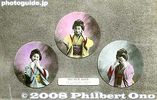
See, hear, nor speak no evil.
|
|
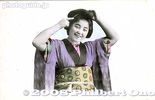
Combing her hair.
|
|
|

Laughing Geisha with fan. There are two Yokohama postmarks on this card. One in Japanese (over the stamp) and one in English. The actual card is more yellowed and almost brown, but I bleached it with Photoshop.There are two Yokohama postmarks on this card. One in Japanese (over the stamp) and one in English. Japanese postmarks have the date in the Year-month-day format. And English postmarks have it in the Day-month-Western year format. As you may know, Japan bases its years on the Emperor's reign. In the Japanese postmark, you can see "36" for the year. That's not 1936, but Meiji 36 that corresponds to 1903. Besides the Meiji Period (1868-1912), there's the Taisho Period (1912-1926) and the Showa Period (1926-1989). Since the Japanese postmark only indicates the last two digits of the year, it can be a pain to figure out which period the year belongs to. In most cases, we can figure it out with the stamp or type of postcard back.
|
|

Laughing Geisha on terrace. It looks like she's on the veranda of a restaurant along a river. If she's a Kyoto geisha, it would be the Kamo River. But these cards were made in Yokohama. I wonder if she was from Yokohama.
|
|

Laughing Geisha looking out. The card is postmarked 1903 from Yokohama. The actual card is more yellowed and almost brown, but I bleached it with Photoshop.
|
|

Laughing Geisha with baby. She's nicely posed, and you can even see the baby's face. But the color of her kimono is somewhat drab. A mother (or married woman) does not and need not wear a colorful kimono.
|
|

Laughing Geisha with umbrella. The sender probably wrote about his incredible adventures in Japan. Postmarked 1904 from Yokohama addressed to Hamburg, Germany. The actual card is more yellowed and almost brown, but I bleached it with Photoshop.
|
|

Laughing Geisha with umbrella. As you may have noticed, the umbrella (and fan) was a commonly used prop in tourist photos. Postmarked 1903 from Yokohama. The actual card is more yellowed and almost brown, but I bleached it with Photoshop.
|
|

Laughing Geisha in the rain. There's a horse in the background. Maybe she's watching a parade. The ground looks wet.
|
|

Laughing Geisha with Basket. It looks like she's dressed for picking tea leaves. This card, which has an undivided back, dates before 1907. The actual card is more yellowed.
|
|

Another shot of her picking tea leaves.
|
|
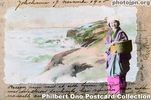
Laughing Geisha on Shore. It's kind of strange to see her at the beach but dressed to pick tea leaves. The message on this postcard was written in French, dated 1905.
|
|

Drawing water from a well.
|
|
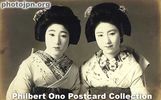
Pair of Geisha, autographed. One of my most treasured cards. This card was signed (on the chest area) by these two geisha with a fountain pen. Several other geisha also signed the back of the card. (See the next image.)
|
|
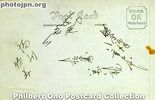
Pair of Geisha, autographed (back). This is the back of the preceding card. It looks like four geisha signed it.
|
|
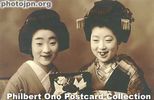
Geisha and maikoNot a good photo, but their names are written in hiragana on the back. They read "Suimatsu" on the left and "Shigezuru" on the right who is a maiko, not geisha. She has more ornaments in her hair than the geisha. Also notice their blackened teeth. If they are in Kyoto, a geisha is called "geiko." In Tokyo, a maiko (apprentice geisha) is called "hangyoku." This is a postcard-size photo and not a postcard.
|
|
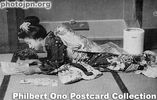
Maiko in Her RoomA private moment. This maiko is lying down in her kimono reading a comic book after getting tired of playing cards. Her mama-san probably would not be pleased to see her wrinkle the kimono like that. Not sure if this was staged or a candid shot. It's hard for anyone to lie down like that in a kimono.
|
|

Oiran courtesan. Also see my photos of an oiran show here. My oiran video at YouTube here.The highest-ranking geisha is called an oiran or tayu. She is escorted by two little attendant girls called kamuro. Notice her high clogs. It takes some skill to walk in those and she usually requires someone's shoulder to hold onto while walking. Sometimes at festivals or special events, you can see the Oiran Dochu procession where she walks in a parade together with geisha attendants.
|
|
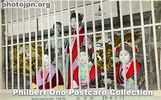
Shin-Yoshiwara prostitutes. They are sitting behind the "cage" which fronted the street for all to see (and choose) within the licensed quarters. Shin-Yoshiwara was a famous red-light district of Tokyo. Note that they are not geisha.Geisha were not prostitutes. This photo was taken during 1907-1911. The woman in the far back was the brothel's matron who supervised this live display and everything else. In 1912 when Emperor Meiji died, this live display of women was later replaced by framed photographs of each woman hung near the brothel's entrance. In 1958, prostitution was outlawed in Japan, and Yoshiwara was history.
|
|
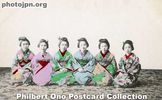
Brothel maids or prostitutes. Maids were employed to guide patrons to their rooms and serve sake and food. Or they could be low-class (cheap) prostitutes. Hand-colored, undivided back.
|
|

Geisha Pair Outside Geisha House. These two geisha know how to pose for the camera. It looks like Kyoto. You can tell that they are geisha because of the shorter kimono sleeve, subdued kimono design (mostly black), and their clogs (for rainy weather).
|
|

Patriotic Maiko. Card designed to encourage soldiers on the front line. Notice that her sleeves are so long that you can see her right sleeve touch the ground. That's the kimono of a maiko. This is a modern postcard reproduction.
|
|

Two Patriotic Maiko. To cheer up the soldiers on the front line, pretty and smiling maiko (apprentice geisha) often appeared on postcards for military mail. This card was postmarked Aug. 1940 from Shizuoka city. It was not addressed to a soldier though.Both women are maiko and not full-fledged geisha yet. The sleeves of a maiko's kimono reaches toward the ground as you can see here. (The sleeves of a geisha is shorter.) The kimono design is also more colorful and gaudy. Maiko also wear clogs called pokkuri. They are wedged at the front, so if you are not careful, you can trip forward. Geisha do not wear pokkuri.
|
|

Smiling Maiko Standing. Great smile. This is the same woman in the card where two maiko are holding the Japanese flag.
|
|

Smiling Maiko Sitting. Real-photo postcard to cheer up soldiers. This card was sent as military mail from Kyoto on New Year's Day 1939. The kanji characters on the fan says "Banzai," the traditional Japanese cheer for victory and happy occasReal-photo postcard to cheer up soldiers. This card was sent as military mail from Kyoto on New Year's Day 1939. The kanji characters on the fan says "Banzai," the traditional Japanese cheer for victory and happy occasions. It also means "long life," something that soldiers would like.
|
|

Laughing Maiko. Another card to cheer up the men at the front line.
|
|

Maiko hair ornaments. Maiko have more ornaments in their hair than geisha do. The hair ornaments differ depending on the current season. They usually have a flower motif, and if you look closely and see what flower it is, you can tell what season it is.
|
|

The maiko uses her real hair, not a wig. When her hair is down, it reaches her chest.
|
|

Smiling Maiko sitting in gardenNotice her left sleeve reaching the ground. A sign of a maiko's kimono, not a geisha's. Also, the high clogs that she wears are called pokkuri. Maiko wear them, but geisha do not.
|
|

Maiko on Gojobashi Bridge. Postcard-size real photo taken in Kyoto. She has been poorly posed. Her posture is bad, her kimono is ruffled, the sleeves look bad, and her feet are pointing in the wrong direction. Maiko usually know how to pose themselves.Postcard-size real photo taken in Kyoto. She has been poorly posed. Her posture is bad, her kimono is ruffled, the sleeves look bad, and her feet are pointing in the wrong direction. Maiko usually know how to pose themselves for a photograph. But not this one. Perhaps she's an amateur.
|
|

Maiko with umbrella. The quickest way to tell if she is a geisha or maiko is by looking at her back. The tell-tale sign of a maiko is her long obi sash hanging down behind. Whereas the geisha's sash has a short knot instead.
|
|
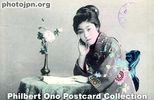
Flower in Vase. Nicely composed photograph. With a serene-looking face, she's an ideal postcard model. She also appears in the next postcard.
|
|

Girl at fence. Her posture is crooked, but somehow this photo looks nice. She's not sensationally attractive, but she's photogenic and comes across well. She also appears in the preceding postcard.
|
|

Woman with two flowers. She's holding the flowers in a cross or "X" mark. I wouldn't call that a good way to hold flowers (unless you're a hula dancer).
|
|

Woman and flower patch. Same woman as in the preceding postcard.
|
|

Girl with Bouquet. Would've been a great shot if she had smiled.
|
|

Woman with flowers. She's wearing two rings on her left hand. She looks like a wife alright. How can you tell? Well, her kimono has a plain design, and the word "married" is written on her face.
|
|

Woman and cherry blossoms. Unfortunately, she's too hunchbacked in this picture.
|
|

Teruha with chrysanthemum. The flower she's holding matches her kimono design that shows the same flower. Her name was Teruha and she appeared in many postcards. She was born in 1896 in Osaka and worked as a geisha in Shimbashi, Tokyo. Click to read mTeruha with chrysanthemum. The flower she's holding matches her kimono design that shows the same flower. Her name was Teruha and she appeared in many postcards. She was born in 1896 in Osaka and worked as a geisha in Shimbashi, Tokyo before becoming a Buddhist priest in Kyoto. Read more about her interesting life by James A. Gatlin at geikogallery.com.
|
|

Teruha sitting.Her name was Teruha and she appeared in many postcards. She's probably still in her teens in this photo. She was born in 1896 in Osaka and worked as a geisha in Shimbashi, Tokyo before becoming a Buddhist priest in Kyoto. Read more about her interesting life by James A. Gatlin at geikogallery.com.
|
|

Rear and side views. Nice side and back shot of a kimono woman. Can't see any wedding ring, but she looks married.
|
|

Tres Flores. Intriguing pose. It looks like a modern postcard, but it's postmarked 1907!
|
|

Typical woman and flower. Give a woman a flower and ask her to pose with it, and this is how she typically would hold it.
|
|

Flower arrangement. She's about to put the flower into the vase made of bamboo. On her lap, there's a pair of scissors used for flower arrangement. Her purple kimono has a design showing wisteria flowers. The season must have been spring.The card was printed in color so it's not that old.
|
|
|

Hagoita Honey poses in Asakusa
|
|

Hagoita Honey
|
|

Hagoita Honey
|
|

Hagoita Honey
|
|
|
|
|
|
|
|
|
|
|
|
|

Asakusa Samba Carnival
|
|
|
|
|
|
|

Tuba player
|
|
|
|
|
|
|
|

Asakusa Samba Carnival
|
|
|
|
|
|

Fuji TV with professional cheerleaders
|
|
|
|
|
|
|
|
|
|

Kaminarimon-dori street
|
|
|
|
|
|
|
|
|

Asakusa Samba Carnival
|
|

Yuka-chan, A.B.S.UNIDOS DO URBANA based in Nagoya at Asakusa Samba 2006.
|
|

Yuka-chan, A.B.S.UNIDOS DO URBANA based in Nagoya at Asakusa Samba 2006.
|
|

Yuka-chan, A.B.S.UNIDOS DO URBANA based in Nagoya at Asakusa Samba 2006.
|
|

Yuka-chan, A.B.S.UNIDOS DO URBANA based in Nagoya at Asakusa Samba 2006.
|
|

Yuka-chan, A.B.S.UNIDOS DO URBANA based in Nagoya at Asakusa Samba 2006.
|
|
|

Asakusa Samba Carnival
|
|
|
|
|
|
|

Asakusa Samba Carnival
|
|
|
|
|
|
|
|
|
|
|
|
|
|
|
|
|
|
|
|
|
|
|
|
|
|
|
|
|

Uniao dos Amadores
|
|
|
|

Barbaros is the most famous troupe, sponsored by Nakamise shopping mall.They had 300 members parading.
|
|
|
|
|
|

Their theme was "games" like roulette.
|
|

Othello
|
|

The 50th Koenji Awa Odori Dance during Aug. 26-27, 2006.
|
|

Koenji Awa Odori
|
|
|

They shout, "Yattosa Yatto Yatto Yoisa Yattosa"
|
|
|
|
|

「ヤットサー ヤットヤット ヨイサー ヤットサー!」掛け声
|
|
|
|

Fool's disguise
|
|

Child dancer
|
|
|
|

Taiko drummers
|
|
|
|
|
|
|

Men dance with their hips down low. 伍楽連
|
|

Women dance with their hips high and knees bent.
|
|
|
|
|
|

Goraku-ren 伍楽連
|
|

Aoi-ren
|
|
|
|

Women sometimes perform men's dances. Goraku-ren 伍楽連
|
|

Koenji Awa Odori
|
|
|
|
|